5 Major Ports in South Korea
South Korea is a developed country situated in the East Asian region. It is the fourth largest Asian economy and the tenth biggest in the world in terms of nominal GDP. Led by electronics, automobile, chemicals and shipbuilding sectors, it has transformed into a high-technology and heavily industrialised nation. The $2 trillion economies was ranked as the 19th freest in the 2022 economic index.
Treading on the path of sustainable infrastructural development, South Korea serves as an example for developing nations of the Asian continent.
Facing the Yellow Sea and the Sea of Japan on its western and eastern borders, it houses the world’s biggest ports and terminals equipped with highly-advanced maritime technologies.
Let us have a look at the five major ports of the country.
1. Port of Busan
The Busan Port is the largest in South Korea situated at the southeastern tip of the Korean peninsula, at the mouth of the river Naktong near the Tsushima islands of Japan. Established in 1876 to facilitate maritime trade with Japan and China, the port has come a long way due to its strategic location and infrastructural development.
Today it is the fifth busiest container port in the world and North-East Asia’s biggest transhipment facility with shipping connections to 500 major ports in 100 countries. More than 80,000 ships visit the port annually carrying 200,000,000 tonnes of cargo. In 2020, Busan handled 21.82 million TEU and aims to become a global logistics hub by attaining a throughput of 30 million TEU in the next five years.
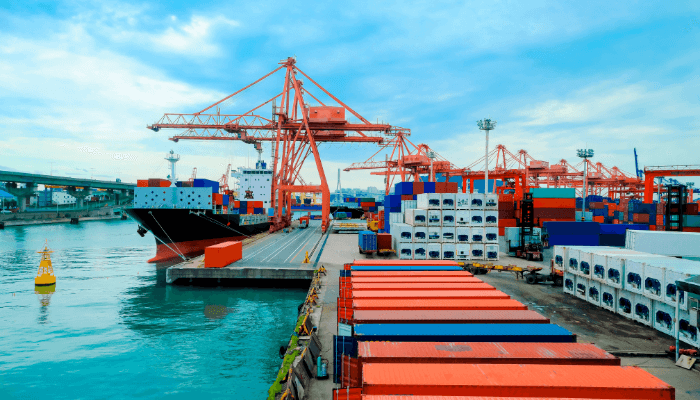
It exports machinery, manufactured goods and containerised cargoes and receives shipments of cement, oil, timber, steel and general cargo. A major industrial centre, Busan also houses numerous shipbuilding companies, chemical plants, paper, ceramics and automobile industries. The city is also famous as a tourist destination, with people coming to enjoy the hot springs and its white sandy beaches.
Busan Port is divided into three main port areas by Yong Island.
Busan North Port is undergoing a development project for transforming the harbour into a major cruise destination with maritime connections to Eurasia and the Pacific. This facility also houses 4 major container terminals.
Jaseongdae Container Terminal has a total pier length of 1447 m and an annual handling capacity of 1.7 million TEU. It can simultaneously accommodate four ships weighing 50,000 DWT. With a 500 m wharf, the Uam terminal handles 300,000 TEU each year. Lastly, the Singamman and the Gamman terminals have an annual capacity of 780,000 TEU and 1.56 million TEU.
Busan New Port was opened in 2006 and has a water depth of 17 m for accommodating ships of 20,000 TEU. It comprises 23 container berths for dealing with more than 10 million TEU.
Southport is the base of the country’s fishery industry with over 30% commissioned sales of seafood, handling around 800 tonnes of fresh and frozen seafood daily. Korea’s famous Jagalchi market located near this facility has been modernised and is expected to grow into a world-class fisheries centre.
Gamcheon Port
A subsidiary port of Busan, Gamcheon Port has a multi-purpose terminal for dealing with coastal and freight cargo like fishery products, cement, sands, and steel.
Dadaepo Port
This facility offers ship repair and maintenance services and also accommodates passengers vessels. It is being developed into an eco-friendly port.
Busan International Passenger Terminal was modernised in 2015. It is equipped with state-of-the-art facilities such as conference halls, luxury lounges and much more. Comprising 14 berths, it can handle 2.8 million passengers annually.
2. Port of Incheon
Incheon port is located at the mouth of river Han just a few kilometres southwest of Seoul, the capital city. It is the second biggest port in South Korea handling passengers, general cargo, petroleum goods, LNG and containers. Consisting of an outer harbour and an inner port, Incheon handles 21,000 ships, 150,000,000 tonnes of cargo and 1,860,000 TEU annually.
It has designated wharves for dealing with chemicals, salt, lumber, iron and steel. Incheon also serves as the maritime gateway for South Korea’s largest economic region, Gyeongin.
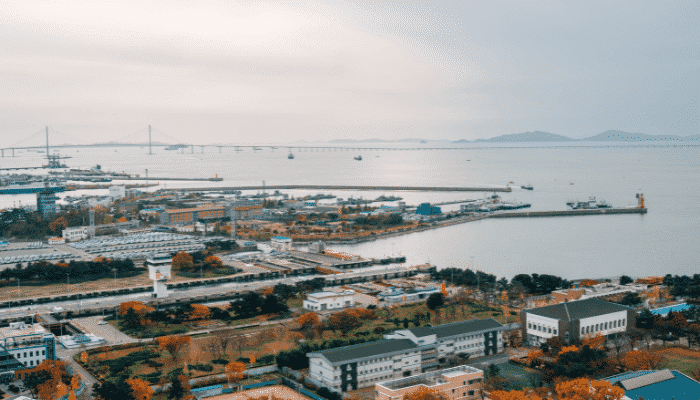
Lying inside the lock gate, the inner port was established in 1974 as the first container handling facility in the country. Presently, it comprises 46 berths capable of accommodating ships up to 50,000 DWT. Vehicles, cars, grains, cereals and other conventional cargo are handled here.
The South Port comprises three container berths and four general cargo berths
for accommodating 4,000 TEU container ships. It also serves small and medium-sized vessels, coastal cargo vessels and barges.
The North Port is a comprehensive facility with 17 wharves for dealing with lumber, steel, subsidiary feed materials, scrap iron and hardwood.
Incheon New Port
Endowed with a high-tech port operating system, the new port has a container wharf comprising six berthing quays for 12,000 TEU vessels. It is being developed as the major logistics hub of the Yellow sea region for handling both general cargo and containers.
The Container Terminal has two wharves covering 600 m with an alongside depth of 14 m for accommodating ships weighing more than 80,000 DWT. It has 10 warehouses for storing containers and a stacking area. The terminal has an annual capacity of 900,000 TEUs.
Incheon International Ferry Terminal incorporates two facilities spanning 9 acres and more than 10 berths. Nine shipping companies provide ferry services to major cities of northern China such as Dalian, Qingdao etc.
3. Port of Donghae
The Donghae port lies on South Korea’s eastern coastline facing the Sea Of Japan. It is the biggest trade port in the eastern region with sufficient water depths for accommodating the world’s biggest container vessels. Given its geographical location, it plays a pivotal role in strengthening South Korea’s maritime trade relations with other Sea of Japan states.
Approximately 3600 ships and over 20,000,000 tonnes of cargo are handled at the port annually. It has numerous terminals that can accommodate ships with a maximum LOA of 225 m and a draught of 12.5 m.
The port has regular shipping lines exporting construction materials like cement, mineral sands and ferro-alloys to China, Russia and Japan. It has major trade relations with Siberia, three provinces in northeast China and western Japanese ports. Principal cargo comprises breakbulk, soft coal, limestone and gypsum. Opened in 1979, it functions as a distribution hub for materials, a centre of industry and maritime trade.
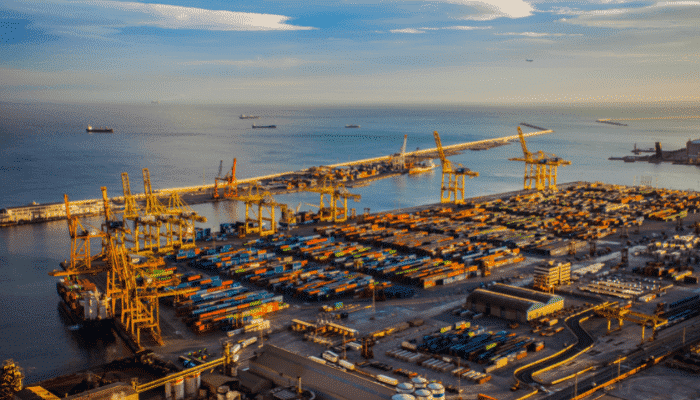
It was constructed primarily as a transhipment facility for clinker, cement and stone however after the completion of the Yeongdong expressway in 2001, it received large volumes of container cargoes. In 1998, a cruise service was started for tourists to Mount Kumgang which made it a popular tourist destination.
Presently, Donghae spans 135 hectares of land area and 100 hectares of waterfront with an artificial harbour having a 20.7-kilometre coastline. In 2021, a 1.8 km breakwater was constructed off the coast of Donghae and seven berths would be built by 2030.
The port is linked to the largest cement plant in the world called the Ssangyong Cement Donghae Plant and the biggest chemical plant in South Korea, the Dongbu Hannong Ferro-alloy plant. The Bukpyeong Industrial Complex and a Logistics Complex are other important facilities located near the port.
4. Port of Masan
Masan port lies near Masan Bay and is connected to Busan by roadways and railways making it a bustling market centre for marine products, the produce of Kimhae plains and the Namchon river valley region. It serves the hinterland and houses textiles factories, chemical plants and traditional breweries. Approximately 12,500,000 tonnes of cargo and 150,000 cars are shipped from its container terminal every year.
Opened in the late 19th century, Masan has evolved into an international trading port due to its well-protected harbour, central location on the southern coast and wide navigation channel which makes it easily accessible to ships of all sizes. It is also a port of call for regular liner services to South-East Asian nations and Northeast Asia.
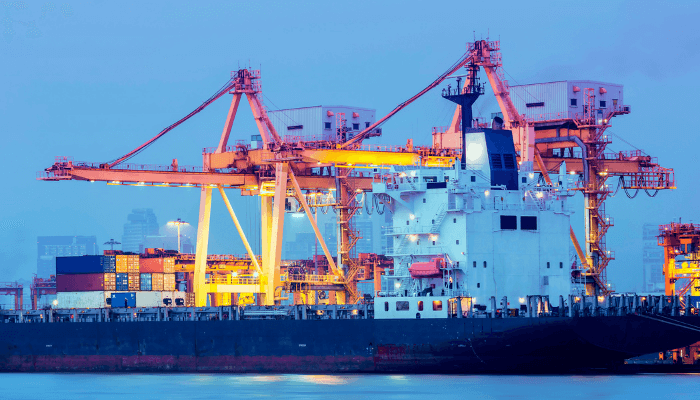
It covers 1400 hectares, stretching along a 28 km coastline with water depths of 12 m and has transformed into a major automobile export facility due to lower port tariffs and short clearance time. Masan’s car terminal comprises an 80,000m2 of the open yard and the container terminal has 11 international routes linking it to the major container facilities in China and other Southeast Asian countries.
The general cargo terminals serve the Masan Free trade Zone and Changwong national industries. It handles logs, ironware, agricultural products etc on its dedicated berths.
The central pier handles 80,000 tons of coastal cargo on its four berths. Pier 3 specialises in frozen fish cargoes. It has two berths for accommodating 20,000 DWT ships. The Dosan pier deals with shipments of heavy machinery and has an annual capacity of 1.5 million tonnes. Suhang pier exports timber while the SK pier is the primary oil handling facility. 2.3 million tons of cement are handled at the Ssangyong pier and the Hanla pier. Lastly, iron is exported from the Doosan and Pochul wharves with a total cargo capacity of 2 million tonnes.
5. Port of Gunsan
Gunsan port also known as Kunsan lies near the mouth of River Kum Kang on the western coastline. This port is famous for shipping rice produced in the neighbouring regions. Infrastructural development started in the 1950s when a thermoelectric plant was constructed adjacent to the main port area along with some industries producing paper, plastics, lumber and rubber products. Linked by railways to Iksan and the Seohaean Expressway, it is an important port housing a free trade zone for attracting foreign investment.
It handles general cargo, RoRo, tankers and containers on its dedicated terminals. A major gateway to China, Northeast Asia and Europe, Gunsan is visited by 1940 ships carrying 1,450,000 tons of cargo and 37,000 TEU each year.
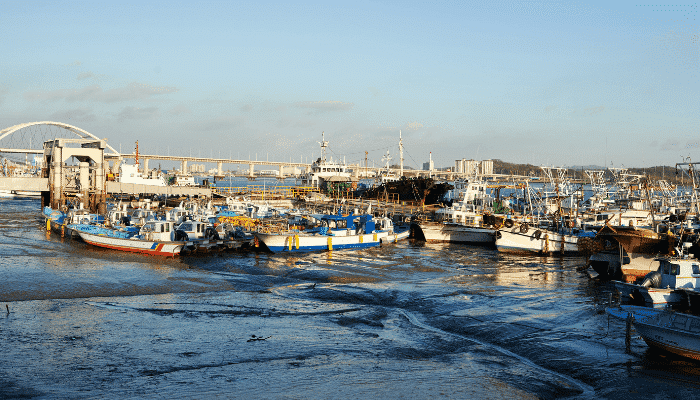
The port has 13 berths covering roughly four kilometres, three floating piers, six dolphins and a 1.5 km fishery wharf. These berthing facilities have an annual handling capacity of more than 8 million tonnes of cargo. Five warehouses measuring 17,500m2 and a 74-hectare open yard can store up to 1.5 million tons of cargo.
The port’s grain terminal has a 600 m wharf for dealing with 1.2 million tons of grains and cereals. It has 9 silo tanks and a fully-mechanised elevator system. The RORO terminal was built in 1997 and comprises a 750 m dock for handling shipments of automobiles. Around 2 million TEUs pass through the container terminal annually.
Janghang Port is a subport of Gunsan and lies in the Chungnam province. Opened in 1938, it comprises two floating docks for accommodating 10,000 DWT ships. It serves the region’s fishing sector and also handles cement and oil. With an annual cargo capacity of 1 million tonnes, it has a storage capacity of 45,000 tons of cargo.
You might also like to read:
- 8 Major Ports in Australia
- 7 Major Ports in Kazakhstan
- 5 Major Ports of Ukraine
- 5 Major Ports in Mozambique
- 5 Major Ports in Colombia
Disclaimer: The authors’ views expressed in this article do not necessarily reflect the views of Marine Insight. Data and charts, if used, in the article have been sourced from available information and have not been authenticated by any statutory authority. The author and Marine Insight do not claim it to be accurate nor accept any responsibility for the same. The views constitute only the opinions and do not constitute any guidelines or recommendations on any course of action to be followed by the reader.
Do you have info to share with us ? Suggest a correction

About Author
Shilavadra Bhattacharjee is a shipbroker with a background in commercial operations after having sailed onboard as a Third Officer. His interests primarily lie in the energy sector, books and travelling.
Latest Maritime Knowledge Articles You Would Like:
Subscribe To Our Newsletters
By subscribing, you agree to our Privacy Policy and may receive occasional deal communications; you can unsubscribe anytime.
















